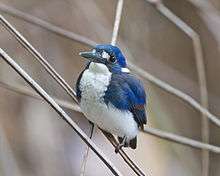Little kingfisher
| Little kingfisher | |
|---|---|
 | |
| Scientific classification | |
| Kingdom: | Animalia |
| Phylum: | Chordata |
| Class: | Aves |
| Order: | Coraciiformes |
| Family: | Alcedinidae |
| Subfamily: | Alcedininae |
| Genus: | Ceyx |
| Species: | C. pusillus |
| Binomial name | |
| Ceyx pusillus Temminck, 1836 | |
| Subspecies [2] | |
| |
| Synonyms | |
|
Alcedo pusilla | |
The little kingfisher (Ceyx pusillus) is a species of kingfisher in the subfamily Alcedininae. It is found in open forest, woodland, swamps and mangroves in Australia (northern Queensland and north Northern Territory), Indonesia, Papua New Guinea and the Solomon Islands.
Taxonomy
The first formal description of the little kingfisher was by the Dutch zoologist Coenraad Jacob Temminck in 1836 under the current binomial name Ceyx pusilla.[3][4] The specific epithet pusillus is the Latin for "tiny" or "very small".[5] There are nine recognised subspecies.[6]
Description
The little kingfisher is 11 cm (4.3 in) long with a rich blue back and head and a snowy white breast. It has a heavy bill and has a short tail. This is one of the smallest kingfishers in the world. Only the African dwarf kingfisher is smaller.[7]
Breeding
The little kingfisher will make a small burrow on the bank of a river during the mating season (October - March in Australia) and will lay 5-7 glossy white eggs at the end of the burrow.
References
- ↑ BirdLife International (2012). "Ceyx pusillus". IUCN Red List of Threatened Species. Version 2013.2. International Union for Conservation of Nature. Retrieved 26 November 2013.
- ↑ http://www.hbw.com/species/little-kingfisher-ceyx-pusillus
- ↑ Temminck, Coenraad Jacob (1838) [1836]. Nouveau recueil de planches coloriées d'oiseaux, pour servir de suite et de complément aux planches enluminées de Buffon (in French). Volume 4. Paris: F.G. Levrault. Plate 595, Fig. 3. The 5 volumes were originally issued in 102 parts, 1820-1839
- ↑ Peters, James Lee, ed. (1945). Check-list of Birds of the World. Volume 5. Cambridge, Massachusetts: Harvard University Press. p. 183.
- ↑ Jobling, James A. (2010). The Helm Dictionary of Scientific Bird Names. London: Christopher Helm. p. 325. ISBN 978-1-4081-2501-4.
- ↑ Gill, Frank; Donsker, David, eds. (2017). "Rollers, groud rollers & kingfishers". World Bird List Version 7.2. International Ornithologists' Union. Retrieved 28 May 2017.
- ↑ Fry, C. Hilary; Fry, Kathie; Harris, Alan (1992). Kingfishers, Bee-eaters, and Rollers. London: Christopher Helm. pp. 216–217. ISBN 978-0-7136-8028-7.
- Graham Pizzey (1980). A Field Guide to the Birds of Australia.
| Wikimedia Commons has media related to Alcedo pusilla. |
| Wikispecies has information related to Alcedo pusilla |
